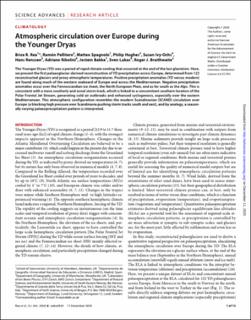Atmospheric circulation over Europe during the Younger Dryas
Rea, B.R.; Pellitero, R.; Spagnolo, M.; Hughes, P.D.; Ivy-Ochs, S.; Renssen, Hans; Ribolini, A.; Bakke, Jostein; Lukas, S.; Braithwaite, R.J.
Journal article, Peer reviewed
Published version

View/
Date
2020Metadata
Show full item recordCollections
- Department of Earth Science [1103]
- Registrations from Cristin [10402]
Abstract
The Younger Dryas (YD) was a period of rapid climate cooling that occurred at the end of the last glaciation. Here, we present the first palaeoglacier-derived reconstruction of YD precipitation across Europe, determined from 122 reconstructed glaciers and proxy atmospheric temperatures. Positive precipitation anomalies (YD versus modern) are found along much of the western seaboard of Europe and across the Mediterranean. Negative precipitation anomalies occur over the Fennoscandian ice sheet, the North European Plain, and as far south as the Alps. This is consistent with a more southerly and zonal storm track, which is linked to a concomitant southern location of the Polar Frontal Jet Stream, generating cold air outbreaks and enhanced cyclogenesis, especially over the eastern Mediterranean. This atmospheric configuration resembles the modern Scandinavian (SCAND) circulation over Europe (a blocking high pressure over Scandinavia pushing storm tracks south and east), and by analogy, a seasonally varying palaeoprecipitation pattern is interpreted.
